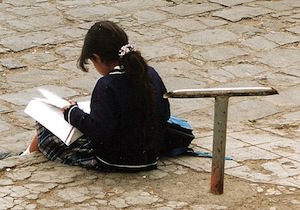Young Latinos Don’t See Themselves in Books
Latino grade-school students don't have many characters to identify with in the books provided in their classrooms. Researchers suggest the fact explains why fewer minority students develop strong reading skills.
Latino grade-school students don’t have many characters to identify with in the books provided in their classrooms. Researchers suggest the fact explains why fewer minority students develop strong reading skills.
Jane Fleming, an assistant professor at the Erikson Institute, and Sandy Ruvalcaba Carrillo, an elementary school teacher in Chicago, reviewed 250 book series written for second- to fourth-grade readers and found only two whose main characters were Latino. The Cooperative Children’s Book Center at the University of Wisconsin-Madison School of Education found in 2011 that just over 3 percent of 3,400 books reviewed were written by or about Latinos. The proportion has changed little in the past decade.
Data compiled in 2011 by the National Assessment of Educational Progress showed that 18 percent of Hispanic fourth-graders were deemed proficient in reading, compared with 44 percent of their white fellow students.
— Posted by Alexander Reed Kelly.
Your support matters…The New York Times:
While there are exceptions, including books by Julia Alvarez, Pam Muñoz Ryan, Alma Flor Ada and Gary Soto, what is available is “not finding its way into classrooms,” said Patricia Enciso, an associate professor at Ohio State University. Books commonly read by elementary school children — those with human characters rather than talking animals or wizards — include the Junie B. Jones, Cam Jansen, Judy Moody, Stink and Big Nate series, all of which feature a white protagonist. An occasional African-American, Asian or Hispanic character may pop up in a supporting role, but these books depict a predominantly white, suburban milieu.
“Kids do have a different kind of connection when they see a character that looks like them or they experience a plot or a theme that relates to something they’ve experienced in their lives,” said Jane Fleming, an assistant professor at the Erikson Institute, a graduate school in early childhood development in Chicago.
… Black, Asian and American Indian children similarly must dig deep into bookshelves to find characters who look like them. Latino children who speak Spanish at home and arrive at school with little exposure to books in English face particular challenges. A new study being released next week by pediatricians and sociologists at the University of California shows that Latino children start school seven months behind their white peers, on average, in oral language and preliteracy skills.
Independent journalism is under threat and overshadowed by heavily funded mainstream media.
You can help level the playing field. Become a member.
Your tax-deductible contribution keeps us digging beneath the headlines to give you thought-provoking, investigative reporting and analysis that unearths what's really happening- without compromise.
Give today to support our courageous, independent journalists.









You need to be a supporter to comment.
There are currently no responses to this article.
Be the first to respond.